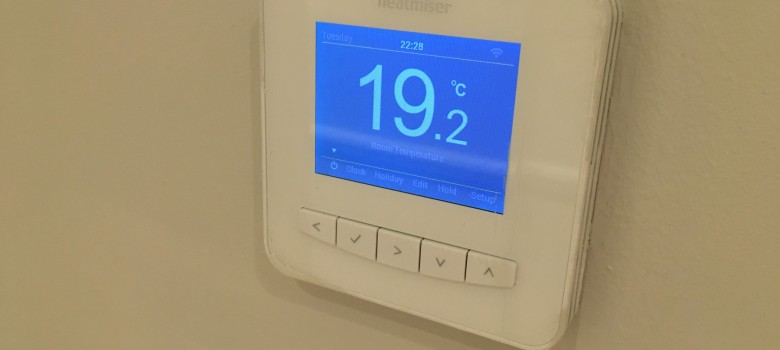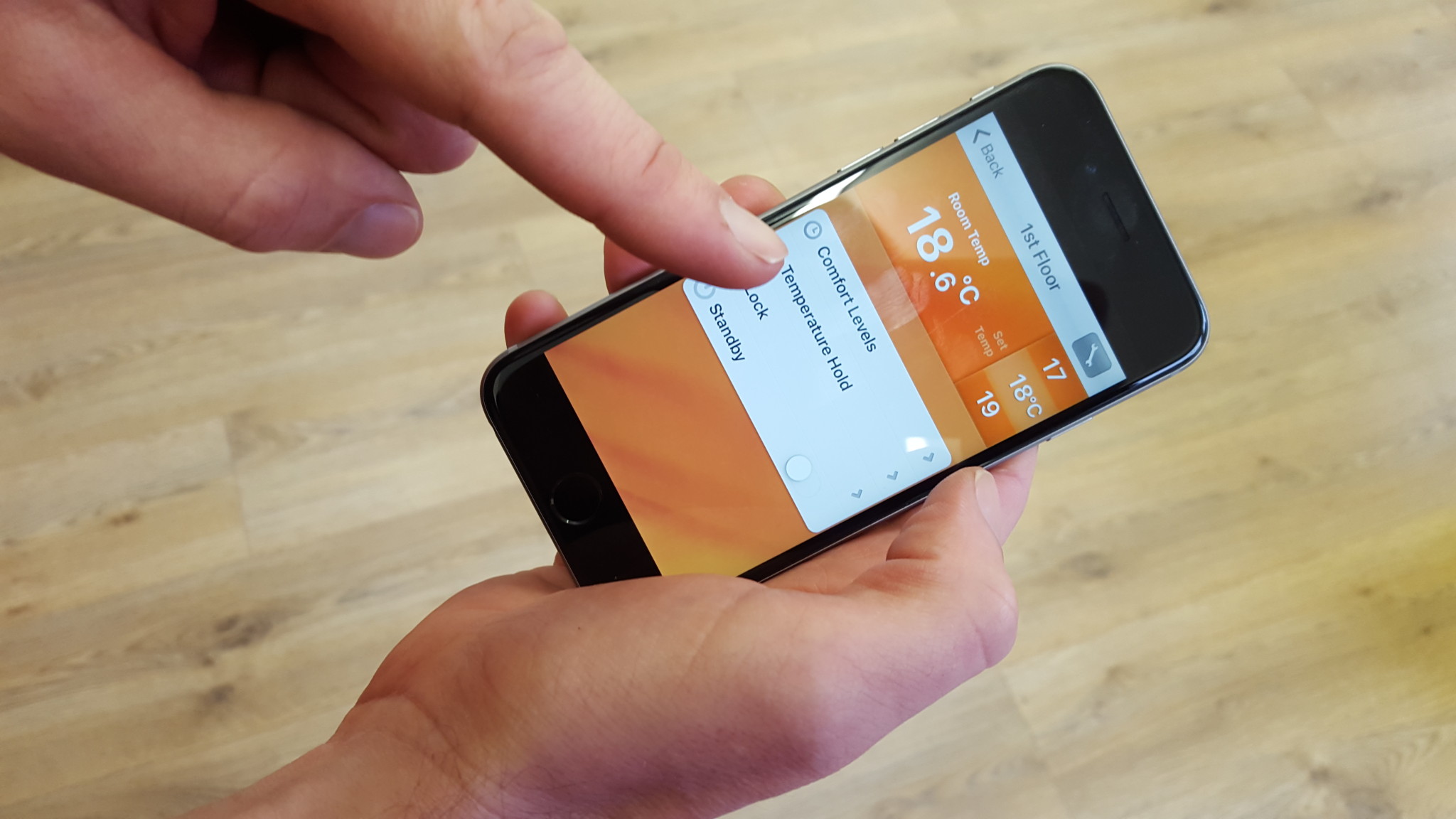
About 9 months ago we moved into our new home – and as such it gave me free reign to install as much energy saving equipment as I liked (which I am sure my partner greatly appreciated!). One of the things I really wanted to get right was the heating controls I installed. There are a huge number of ‘Smart Controls’ currently available to give you better control over your heating – so here I wanted to briefly look at the one I went for and my reason for choosing that particular one over all the others currently available.
To set the scene, our property is a traditional Victorian mid terrace – the place was gutted so we had the chance to insulate the house to within an inch of its life. In addition, we also had access to put in a new more efficient heating/hot water system. We decided to keep traditional radiators upstairs, but downstairs we opted to install underfloor heating in an effort to maximise space.
As a result, the Smart heating controls had to be able to handle both underfloor and radiator heating systems as well as the ability to produce hot water, since we installed a system boiler with a pressurised hot water tank. The plan was to create four separate zones – two for the underfloor heating downstairs, one for the first floor and a final one for the loft room – this was important since these zones were used in different ways with different heating requirements.
The one thing we had in our favour was that we didn’t have to go for a wireless thermostat – we could go with a wired version because we could bury the wires within the stud walls while the house was being rebuilt. This meant that we had a lot of choice in thermostat, because Hive, Nest, Tado and Heatmiser – four of the big players in the market – all require a wired connection. Obviously you could try and retrospectively hide the wires (basically in wired systems there is a wire running from the thermostat unit to the zone valve which is normally situated by the boiler) but it is always going to be a struggle. We would have had a much slimmer choice if this was not the case – I think it is just Heat Genius and the EvoHome that offer wireless connection.
So which did I go for? Well I am assuming from the title you can guess I went with the Heatmiser SmartStats.
Initial thoughts on the Heatmiser SmartStat
There are a few reasons why I chose this one. Firstly I had heard really good things from colleagues and friends in the industry (including a senior man at Honeywell!) – so here are my first thoughts on having had the system for the last 4-5 months:
- The Heatmiser Smartstats are pretty slick on the wall. The units look very neat and aren’t overly bulky – presumably in part because they are wired so don’t need any wireless kit within them. This was one of the key requirements set by my partner, hence it is no.1 on the list – she hasn’t complained so I guess I can take that as a win!
- The Smartstats and the associated app are very easy to use – the app allows everything to be controlled remotely and although I don’t use the Geofencing feature it is there if required – geofencing is simply a setting where the thermostat knows when you are in / out of the house and automatically sets the heating accordingly to save on heating costs if no-one is at home. I like the way Heatmiser have really opted for simplicity; I honestly think even if someone were given the app, they would be able to figure it all out with 10 minutes or so.
- Comfort levels – this is fundamental to how the Smartstat works. The comfort levels are temperatures that you set to ensure the house is the temperature you want when you want it. In the old days you set a time for the heating to come on and it would fire up until the air temperature reached what was required – normally governed by the thermostat – at which time it turns off. With the Heatmiser SmartStat, you say you want the house to be a certain temperature for when you wake up, when you leave for work, when you get home and so forth and it will learn how long it takes to get the house to get to the required temperatures and then turn on the heating the right time in advance so it is at the perfect temperature at all these times – it works very well.
- Since I have a hot water tank, it was pretty fundamental that I had control over when my hot water came on. Believe it or not, the Nest thermostat has only just started being able to control hot water. The downside of this (and I understand why but that isn’t the point) is that I need a whole separate thermostat unit to control the hot water. In order to set the Heatmiser Smartstat to control the hot water you need to set it up in Time Clock Mode (as opposed to thermostat mode). You simply then decide how many hours the hot water is on for – and an appropriate time for it to come on. This functionality too can be controlled from the SmartStat app on iphone if you need to change it or set a boost remotely to ensure there is enough hot water to come home to.
Are there any issues with the Heatmiser SmartStat?
Having to spend extra for the hot water control! It is a clever work around, but it would have been great to have one master unit that controls the temperature in one zone and also does the hot water instead of having to buy separate thermostats for each zone and an additional one for the hot water.
Next, my thermostats initially struggled to stay connected to the internet – I am not sure where the blame sits there – is it my Sky Broadband or is it SmartStats? To be honest, I have a wireless printer connected to the broadband and that never seems to drop out, but maybe I was just unlucky. I spoke to the tech team at Heatmiser when I was having these issues and they told me that they could send a firmware update remotely to the thermostats provided I could get them to stay online for long enough. It seems to have done the trick (touch wood) as you can see from my photo below the zones are all there with temperatures being recorded.
Not using the floor sensor for the underfloor – this strictly shouldn’t be in the issues pile, but I thought I may as well mention it so others don’t fall into the same pitfall. Basically, when you lay underfloor, they recommend laying a floor sensor to record the temperature. I had laid my floor before making my mind up on what thermostat I was going to buy, so by the time I opted for the Heatmiser model it was too late to use the floor sensors. Instead I have to control the underfloor heating with standard air temperature sensors. This is fine, but it means I have to set the comfort levels on those two zones very very low otherwise the rooms get warm!
I appreciate that this is totally my fault, but it is still annoying!
The final thing, and not really a problem for me, was that the Heatmiser SmartStat doesn’t offer individual TRV control. The TRV is the temperature control on the radiator – and there are systems (namely Heat Genius and EvoHome) that do allow a fully integrated thermostat / TRV / programmer system. The truth is I have no need for it and I think it would have been a waste of money for me – but for some people it might be an important thing!
So there you have it – if you have any specific questions about the Heatmiser SmartStat ask in the comments section below and I will be sure to come back to you with an answer if I can! If you wondering the cost of the SmartStats were £125 each so a total outlay of £625 – obviously not cheap, but this is my geeky thing so don’t judge!
Think we missed something? Do you have a different opinion?
Comment below to get your voice heard…













Was considering buying this thermostat, but had no idea it was wired. Do you know if it comes in a wireless version (from the unit to the two way valve?). As you mention, I unfortunately don’t have the luxury of burying the pipes in the wall!
I am so looking at the heatmiser control and am wondering what are the differences between the smartstat and neostat which is much cheaper. Have you considered neostat and if yes, what made you go for the smartstat at double the cost? Thank you.
Hi Milo, it is basically the fact the Neostat has to have an additional Hub unit. The Smartstat units link directly to the broadband router. The functionality is pretty similar though. I have the smart stats in my house and they are great, although it is a wired system – so unless you have a way of hiding the wire – they will look pretty unsightly. I put the wires within the stud walls when building the place so it was okay…
Hi. So we’ve just moved into a house with a garden office which ha a heatmiser system wired into it to I believe two of the wall sockets. Which I suppose means that I can plug electric heaters into those two sockets and control them from the heatmiser control? Does it matter then what sort of electric heater I plug in and I presume I wouldn’t use electric heaters with built in thermostats as they would I presume cancel each other out?
Hi
Thanks for this very useful
I am under process of refurbishing my house and decided to install underfloor heating and wanted to know your experience so far with heatmiser
If I would to install this would you recommend me and would you install the same in your second house
What are the underfloor heating sensors and where can buy
The latest upgrade to the app is terrible, the stat screen is OK with a couple of color options however the menu at the bottom or the zones and settings pages consists of grey text on a grey background with a washed out brown dot showing the zone temperature, this unimaginative use of color in the app makes it boring and not at all easy to see in sunlight, really poor effort and not at all developed with the end user in mind and needs to be rectified
The last upgrade on the Neo system is garbage, the colors are weak and monochromatic with no imagination used whatsoever, I have contacted Neo several times and they promised to fix it but it’s not of course, it seems like they don’t really care about the user interface which isn’t doing their corporate image much good